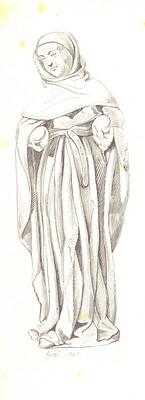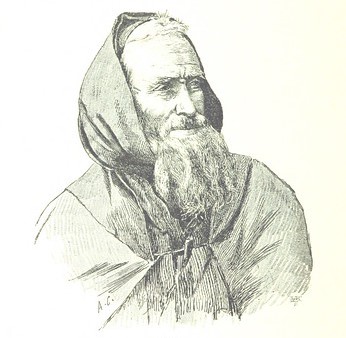Clothing in Anhara
History
Anharan society is entirely based around status, and for a foreigner to walk through the capital of Meridia, or any large family seat, is an ostentatious attack on the senses. While the soaring marble arches and the tops of bluestone capped spires glistening in the sun make one instantaneously aware of what social class dominates that portion of a city, one of the most glaring identifiers of wealth is dress. The more wealth, and therefore less proximity to menial tasks or perspiration, one has, the more they can afford to dress in the manner of their forefathers. This style, of light-weight robes blowing in the winds, is a way to both be close to the forces of their gods, Vestria and Mistra, and to demonstrate the carefree nature associated with wealth.Upper Class
"During the funeral of the Rhetorlord today, Lord Thewisy's robes were suddenly picked up by the wind and billowed out into a train stretching four rows of mourners. Truly a fortuitous sign for his bid for the title." - The Whistling ObserverAs alluded to previously, proximity to the winds is the main social indicator in Anharan society. The wealthiest of the wealthy occupy the highest segments of the city, and the most important governmental buildings are often times entirely open to the elements through the use of arches. This theme is continued in manners of dress as well, with the highest ranking members of society able to wear the sheerest robes. However, while the citizens of greatest social status don the most diaphanous robes, only those also of high rank and title wear the longest. In ceremonies, both governmental or religious, such as sessions of the The Rostrum or funerals, the lengthiest robes are worn. During these events, if one's robes are billowed out by the wind, it is seen as a good omen, especially if they are blown further than a rival.
Formal Wear
A Priestess of Vestria in Ritualistic Garb, Note the Lack of a Veil. Among members of the government, the longest and most lightweight robes are to be worn only for official ceremonies. Besides saving these delicate garments for when they are truly needed, it is simply impractical to attempt to wear them in every day life. To be walking through the market only for a gust of wind to pick up, billowing piles of robes out into the faces of passers-by, would be most uncouth. In fact, the only citizens legally authorized to wear robes capable of billowing in the wind, are those related to an official noble family or otherwise allowed by specific government decree. However, given the cumbersome and expensive nature of the clothing, the lower classes saw little need to protest a change that hardly affected them."The most tempestuous shades of blue may only be worn by those who's duties are stormiest, the leaders of the nation upon who's shoulders rest all our lives." - The Book of Etiquette, "Dress"While these robes were worn by the upper class, not all nobles are created equal. To show the station of the wearer, trims of color are used as laid out in the Book of Etiquette, with the shades most similar to a calm sky representing the lowest stations of the wealthy, and increasing in tempestuousness as duty and rank increases. The Rhetorlord wears his robes, formal or informal, trimmed in purple to show that the great burden of rule is most like a storm, capable of sudden devastation if gone wrong. From this, the shades are laid out in a decreasing manner, with Rhetors wearing dark blue, and Patriarchs (if not in their possible role as Rhetor) wearing a lighter blue. However, members of the original noble houses, regardless of current actual power, rank just below Patriarchs in this color-coded system of formality, then followed by members of younger noble houses in a shade lighter than their elders, once again irrespective of current power. Below these are members of vassal houses, then wealthy nobles, selected by decree of the Rostrum, and then the general gentry wearing palest blue.
"The veils of Priestesses are to be worn covering the face during only the most significant ceremonies, in accordance with the tradition began following the loss of Lady Vestria's Veil" - The Book of Etiquette, "The Priesthood"While the color system exists regardless of the type of social event, formal clothing is not worn unless warranted by the situation. This may include religious events, funerals, weddings, government events, formal parades, and parties. The only notables of society who wear robes of longest length and lightest weight constantly, are the members of the College of Vestrial Priestesses. These priestesses wear the most diaphanous robes of purest white, so thin that many layers must be applied so as not to reveal anything unseemly. Topping off the priestesses' clothing is a veil, worn only during the most sacred events, thrust backward behind the head in the traditional manner.
Everyday Wear
While the average day for the wealthy is less formal than the occasions mentioned above, unlike the lower classes, there is little strenuous activity taking place. The main change in clothing comes in the area of the sleeves, with far less cumbersome methods being adopted than above. So as to allow for the free use of limbs, the sleeves are both tightened and shortened in length, often times only coming down to the elbow in warm weather. While fashions between men and women are very similar during formal events, differences grow during informalities. Women generally maintain the length of formal wear in their everyday clothing, while men's fashion allows for the freer movement of legs by cutting robes off around the knees.Satire & Subtleties
The Agalma of the Maiden, with her bare shoulder indicating the seeking of a suitor. There are a variety of subtle ways that members of the upper class, in particular women and politicians, use their fashion to convey messages. One example, as displayed by the Maiden above, is for young women in search of suitors to display the shoulder during parties or in public spaces. As directly seeking out potential husbands is a vulgar act, this method cropped up to allow wealthy women an opportunity to proactively make their intent known, rather than passively wait."For a young woman to actively seek suitors, especially without prior formal announcement by their father or Patriarch, is vulgarity bordering upon uncouth." - The Book of Etiquette, "Manners"Another common method is the folding of robes at formal events such as dinner parties or during sessions of the The Rostrum. Friends or political allies generally have signals agreed upon only by them, to be used to demonstrate, for example, agreement upon an issue brought up during a speech, where it otherwise would be inappropriate or impossible to verbally communicate. Hypothetically, this system may look like the left arm's loose robes being placed diagonally, to drape over the right shoulder to signal the intent for an affirmative vote. Other symbols may include the lower portion of the formal robe being hiked up above the knee, to show intent to speak on a matter of debate, or the tightening of the middle portion of the robe during a party to show an intent to leave soon, thus avoiding entangling conversations.
"In the bucolic lands outside of the capital region, there is never a robe in sight nor a speech to be heard, and the mind is at ease." - Idyllic LivingThe robes of the wealthy are rarely seen outside of the Coquet Heights, exempting formal events in family seats or funerals. This is owed to two major differences between urban and bucolic settings, firstly the absence of a large wealthy class, and secondly a more familial set of values. Among the countryside seats of noble families, especially smaller houses, the upper class of the town generally consists of the immediate noble family and merchants considered wealthy in that particular area. Most of these residents would be ineligible to wear the robes in any of the color schemes described above, except for the Patriarch and his immediate family. This brings the second factor into play, as the nobility's attitude outside of the capital is less snobbish and more familial. As the Patriarch of a noble house is the main provider of protection, dignity, and religious connections to his citizens, he acts as a father-figure not just to his family, but to the residents of his house's territory as well. Therefore, there are few occasions formal enough to warrant the wearing of the ceremonial robes above, besides infrequent occurrences, such as a state visit or major funeral. Depending upon one's location, either of these traditions may be mocked. In the countryside, such as within the book Idyllic Living, an account of rural life satirizing residents of the capital, the length and intricacy of flowing robes are directly correlating to the bloviating qualities of the wearer, and subject to ridicule. However, the opposite is true in the cities, where writers and poets mock the nobles based in the countryside as bumpkins who lack formal robes because they are too unintelligent to figure out how to wear them.
Lower Class
Formal Wear
A Resident of the Fog District in Listening Attire Among the lower classes, robes of the thread-count, length, and quality of those of the upper class would be both expensive and impractical. Thus, the poorer residents of the city compromise, and for formal occasions wear imitation robes of a thick wool, meant to replicate those of the upper class while remaining inexpensive. They must also be capable of being made and repaired at home, to keep costs down. Given their uncomfortable fabric and stiffness, these are worn only for interactions with the wealthier classes, such as Listenings, where speakers debate a topic to both convince and inform the masses. However, religious activities also demanded fine dress, such as funerals and weddings."Regardless of rank, robes are to be worn for all religious ceremonies, so Vestria's winds may be amongst her people." - The Book of Etiquette, "Dress"
Everyday Wear
An Elderly Craftsman in the Mist District, Keeping His Head Dry In the lower levels of the capital, particularly the Arcus, Mist, and Fog Districts, spray from waterfalls is a constant risk to both fine clothing and work being done in the street. As many craftsman utilize communal work areas, such as kilns for tile making or open markets for the selling of produce, keeping oneself dry is crucial. From that need, most everyday wear for the workingman has developed with some sort of head covering, generally a good, such as pictured above. Beyond this theme, outfits worn in the lower levels are as variable as the materials available to families. Most clothing has been handed down or changed over time, with patches or other repairs being applied to save money. Furthermore, anthropological interest in the fashion of the poor of Meridia is slim, and few historians, given their upper class leanings, have taken the time to study it. In the countryside, this same general rule applies, however with the absence of a necessity for head coverings.
Item type
Clothing / Accessory
Raw materials & Components
Lower Class: Rough Wool Upper Class: Lawn Cloth & Silk Trim





Comments